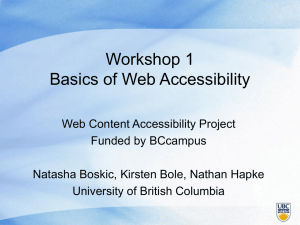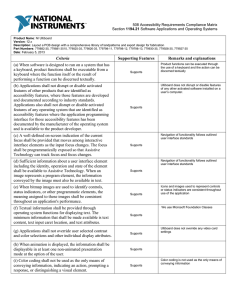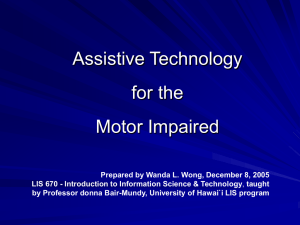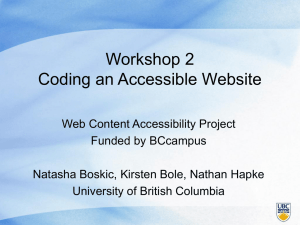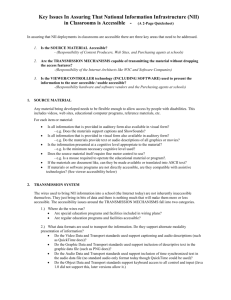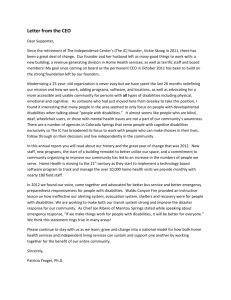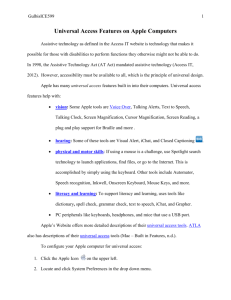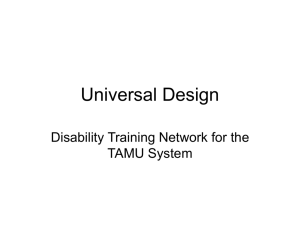Disabilities & Assistive Technology
advertisement
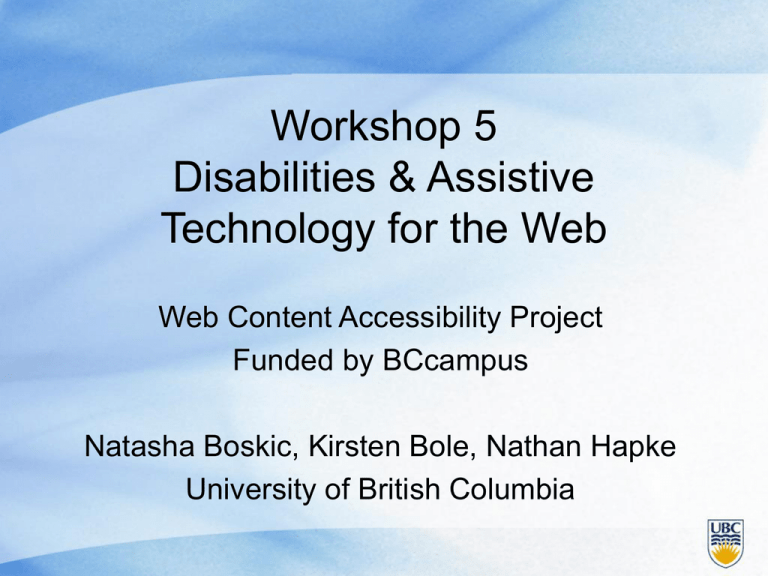
Workshop 5 Disabilities & Assistive Technology for the Web Web Content Accessibility Project Funded by BCcampus Natasha Boskic, Kirsten Bole, Nathan Hapke University of British Columbia Workshop schedule • Monday August 21 Basics of Web Accessibility • Tuesday August 22 Coding an Accessible Website • Wednesday August 23 Accessible Multimedia • Thursday August 24 Creating Usable Content • Friday August 25 Disabilities & Assistive Technology The Plan • Overview • Types of disabilities • Technologies that address them What you’ll get out of this • Understanding of disabilities and how they affect computer use • Learn what technologies can be used to get around these obstacles • Can take this knowledge into consideration when planning an online course or website… • …and when accommodating a disabled student in a classroom course. Types of disabilities • • • • Learning/Cognitive Visual Physical/Motor Hearing Learning/Cognitive • Learning & emotional disorders most common disability at UBC • Learning disorders: dyslexia, dysgraphia, ADHD • Cognitive disorders: brain injury, autism, dementia • Most difficult to adapt for since there is so much variation Difficulties experienced • • • • • Attention & concentration Resolving written words Comprehension of written text Planning and time management Problem-solving Everyday items • • • • • Not all AT has to be high-tech Day planners Calculators Sticky notes & highlighters Spelling & grammar checkers Assistive technology • Similar to low-vision AT • Screen reader reads text aloud • Literacy software aids with pronunciation, highlights current line being read • Predictive typing helps choose right word • Time management software, palmtops • Academic advice & consultation Vision • Most profoundly affected by Web • Web is extremely visual • Web developers need to accommodate needs more than for any other group Vision • Screen reader (JAWS) • Screen magnifier (Zoomtext) • Braille displays Physical/motor • • • • Little or no control of hands Injury or condition Adaptive keyboards & pointing devices Built-in accessibility features for Windows and Mac • Additional software Adaptive keyboards • Keyguards allow hands to rest on keys • Mini-keyboards minimize hand motion • Datahand uses finger movement only… • orbitTouch needs no fine movement at all. Adaptive pointing devices • • • • • Many alternatives to the standard mouse Also can help prevent RSI Trackball Trackpad Graphics tablet Hands-free computing • • • • Voice recognition software On-screen keyboard Head-tracking mouse Foot mouse Accessibility features in OS • Windows & Mac – – – – – Sticky keys / filter keys Screen magnifiers Mouse & cursor control Keyboard navigation Visual alert • Windows – On-screen keyboard • Mac – Speech recognition for specific commands Hearing • • • • • Web most beneficial to hearing-impaired Obstacles include videos, mp3s, podcasts Often not essential to course material Closed-captioning, transcripts Hearing aids Try it yourself… • Change the accessibility options in your OS. • Can you navigate a web site by keyboard alone? • Download & try a trial version of a screenreader. Can you understand a site read aloud without looking at the screen? Thank you for coming! • Natasha Boskic (natasha.boskic@ubc.ca) • Kirsten Bole (kirsten.bole@ubc.ca) • Nathan Hapke (nhapke@interchange.ubc.ca) • Thanks to the Neil Squire Foundation for introducing us to different types of assistive technology.
